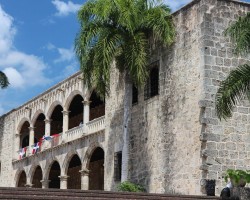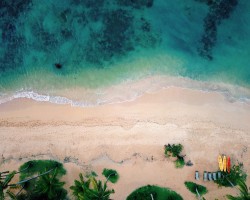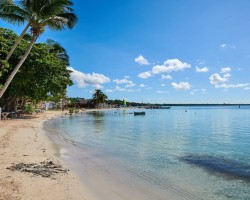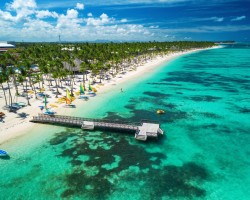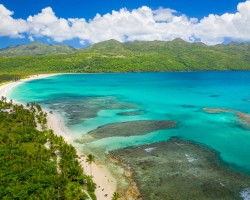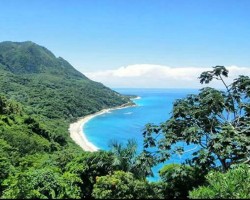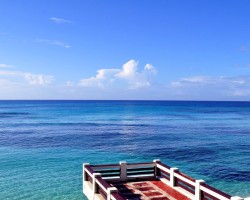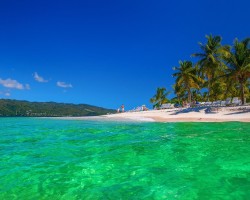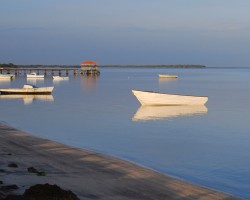Best time to go to the Dominican Republic for a perfect weather and where to go?
When is the best time to go to the Dominican Republic?
It is possible to recharge your batteries on the beautiful beaches of the Dominican Republic all year round. However, the best time to visit the Dominican Republic is during the dry season, which runs from mid-December to late April. During this period, rainfall is relatively low. The climate is hot and sunny.
This season also coincides with the high tourist season. You will find a large influx of visitors, especially during the year-end holidays and during the Holy Week leading up to Easter.
So, if you are wondering when to visit the Dominican Republic to avoid the crowds, it would be advisable to adjust your trip by a few weeks compared to these peak periods.
Observing humpback whales in the Dominican Republic is also ideal during this period, especially from January to late March.
Moreover, the low season in the Dominican Republic is not so bad. In fact, during the wet season, which lasts from May to October, the weather remains very pleasant on the island. There are mostly sunny days and although rains are frequent, they are short-lived.
Furthermore, the water temperature is ideal for swimming and scuba diving during this season. However, the heat can sometimes be difficult to bear.
The wet season also coincides with the hurricane season. Indeed, from June to November, the Dominican Republic can be affected by hurricanes. Nevertheless, these events are quite rare: they do not hit the island every year.
Finally, as there is a decrease in precipitation from July to September, the summer school holidays period is also very busy.
Where and when to go based on the weather?
East of Dominican Republic
Punta Cana, Bayahibe, Miches...
Eastern Cibao
Las Terrenas, Samana, Cotui...
Greater Santo Domingo
Santo Domingo, Boca Chica, Baní...
North (Western Cibao)
Puerto Plata, San Fernando de Monte Cristi
, Santiago de los Caballeros...
South of Dominican Republic
Barahona, Cabo Rojo, Azua de Compostela...
To get all the information about the climate and weather in the Dominican Republic for a specific month, click on the corresponding link below:
Dominican Republic in january Dominican Republic in february Dominican Republic in march Dominican Republic in april Dominican Republic in may Dominican Republic in june Dominican Republic in july Dominican Republic in august Dominican Republic in september Dominican Republic in october Dominican Republic in november Dominican Republic in december
Best time to travel to Dominican Republic by cities
Climate and Weather in the Dominican Republic
Located off the United States and Cuba, the Dominican Republic is the eastern part of the island of Hispaniola, which also hosts Haiti. Ideally situated between the Equator and the Tropic of Cancer, this island benefits from a tropical climate, pleasantly tempered by the presence of trade winds.
The climate of the Dominican Republic has two seasons:
- the dry season from December to April
- the rainy season from May to November
Nevertheless, the sunshine rate in the Dominican Republic is significant all year round.
Furthermore, the sea, both on the side of the Atlantic Ocean and the Caribbean Sea, enjoys a temperature always ideal for swimming.

Climate in the Dominican Republic: the dry season
This season is the most pleasant in terms of climate in the Dominican Republic. Indeed, the weather is dry and sunny, and the temperatures are slightly cooler than in summer. They range between 20 and 30 °C on average.
Moreover, a cool wind from the United States sometimes blows over the island, helping to lower the temperature by a few more degrees. Thus, temperatures can drop to below 10 °C in mountainous areas.
Nevertheless, the climate remains tropical: mostly warm and pleasant. However, rain can occur regularly even during this season. Indeed, showers may occur in the late afternoon or evening, but they usually stop within a few minutes.
Some areas are also more prone to bad weather. For example, the Samana Peninsula experiences 100 mm of rain per month during this period, and it can rain for 20 days out of 30. Additionally, in Sabaneta or Barahona, rainfall is almost nonexistent during the dry season.
Climate in the Dominican Republic: the rainy season
There are actually two rainy seasons in the Dominican Republic:
- the first one occurs from May to early June
- the second one happens from October to November.
Thus, the months of July to September, often favored by travelers, have a more favorable climate.
However, it is in the Samana region that this decrease in rainfall in summer is most noticeable. Indeed, more than 200 mm of rain falls in May and sometimes less than 150 mm in June and July.
In other regions of the island, there are more regular precipitations from May to November. This is the case in Punta Cana and Santo Domingo, for example.
In any case, the rainy season in the Dominican Republic is characterized by high temperatures and a heavy atmosphere. Temperatures range between 27 and 33 °C on average.
Showers are frequent during this period. However, they often come in the evening and rarely last more than an hour.
Moreover, like nearby Florida, the Dominican Republic is sometimes affected by hurricanes that can cause significant damage. The hurricane season extends from June to November, but most of these events occur in August and September.
While hurricanes are rare, tropical storms, of moderate intensity, can hit the Dominican Republic every year. These events bring torrential rains and strong winds.
However, it is not necessary to avoid the hurricane season at all costs when planning a trip. These events do not occur every week. Therefore, there is no need to worry excessively: the local population has learned to live with this risk. If your trip coincides with a storm or hurricane, you will simply need to follow the security measures in place.
Climate of the Dominican Republic: Regional diversities
Beyond the climate disparities between the wet and dry seasons, it is noted that the weather in the Dominican Republic varies from one region to another.
Indeed, the presence of mountainous reliefs tends to increase or decrease the effects of the trade winds.
Thus, there are very humid and green areas in the northeast of the island, such as in Samana. In this region, the difference between the wet and dry seasons is less pronounced. Rainfall is frequent throughout the year.
Furthermore, other regions of the Dominican Republic are almost desert-like during the dry season, such as in San Jose de Ocoa or around Lake Enriquillo.
The plains region, like the area of Punta Cana, is also much drier and less windy.
On the other hand, the southern coast, especially in Santo Domingo, is also very exposed to precipitation as it is not protected by mountains. Therefore, significant showers are found in this area.
Finally, mountainous areas, for example in Constanza, experience cooler temperatures, especially at night.
Temperatures and rainfall in the Dominican Republic
On these 3 graphs, we present the evolution of temperatures of Dominican Republic and month-by-month rainfall for the cities of Santo Domingo, Las Terrenas, Puerto Plata, Punta Cana and Azua de Compostela, as well as the month-by-month sea temperature for coastal cities.
Peak visitor numbers and tourist seasons in the Dominican Republic
Find out when Dominican Republic has its high tourist season (the period when the influx of tourists is highest) and off-peak tourist season using our data and figures.
Tourist seasons in the Dominican Republic
The months with low numbers of tourists are: March, April, May, June, July, August, September, October and November. The number of visitors to Dominican Republic is high in: January, February and December.
- Very low season in the Dominican Republic: May, June, September and October.
- Low season in the Dominican Republic: March, April, July, August and November.
- High season in the Dominican Republic: January and February.
- Peak season in the Dominican Republic: December.
Figure: Visitor index for Dominican Republic month by month
Average price for flights to the Dominican Republic
A return flight between New York City and Punta Cana is generally cheaper if you go in september ($ 420 on average): this is the best time for travellers on a tight budget. In contrast, you may end up paying $ 299 more for your airline ticket to Punta Cana if you go in december.
Find the best price for your flight Flight prices to the Dominican Republic
Where to go in the Dominican Republic?
This table allows you to see the maximum temperature for each city and our opinion on the weather month by month (see colour legend below the table).
| Cities | jan. | feb. | mar. | apr. | may | jun. | jul. | aug. | sep. | oct. | nov. | dec. |
| Santo Domingo | 29°C | 29°C | 29°C | 30°C | 30°C | 31°C | 31°C | 32°C | 32°C | 31°C | 30°C | 29°C |
| Las Terrenas | 27°C | 27°C | 27°C | 28°C | 29°C | 29°C | 30°C | 30°C | 30°C | 30°C | 29°C | 28°C |
| Puerto Plata | 27°C | 27°C | 27°C | 28°C | 29°C | 30°C | 31°C | 31°C | 31°C | 30°C | 29°C | 27°C |
| Punta Cana | 27°C | 28°C | 28°C | 28°C | 29°C | 30°C | 30°C | 30°C | 31°C | 30°C | 29°C | 28°C |
| Azua de Compostela | 27°C | 27°C | 27°C | 28°C | 28°C | 28°C | 29°C | 29°C | 29°C | 28°C | 28°C | 27°C |
| Baní | 28°C | 28°C | 28°C | 29°C | 29°C | 30°C | 30°C | 31°C | 31°C | 30°C | 30°C | 28°C |
| Barahona | 28°C | 28°C | 28°C | 28°C | 29°C | 29°C | 30°C | 31°C | 31°C | 31°C | 30°C | 29°C |
| Bayahibe | 29°C | 29°C | 29°C | 30°C | 31°C | 31°C | 32°C | 32°C | 32°C | 31°C | 30°C | 29°C |
| Boca Chica | 29°C | 29°C | 30°C | 30°C | 31°C | 31°C | 31°C | 32°C | 32°C | 31°C | 30°C | 29°C |
| Cabo Rojo | 28°C | 28°C | 28°C | 28°C | 29°C | 29°C | 30°C | 31°C | 31°C | 31°C | 30°C | 29°C |
| Cotui | 27°C | 27°C | 27°C | 28°C | 29°C | 30°C | 29°C | 30°C | 31°C | 30°C | 28°C | 27°C |
| Miches | 28°C | 28°C | 28°C | 29°C | 29°C | 30°C | 30°C | 30°C | 31°C | 30°C | 29°C | 28°C |
| Samana | 27°C | 27°C | 27°C | 28°C | 29°C | 29°C | 30°C | 30°C | 30°C | 30°C | 29°C | 28°C |
| San Fernando de Monte Cristi | 27°C | 27°C | 27°C | 29°C | 29°C | 30°C | 30°C | 31°C | 31°C | 30°C | 28°C | 27°C |
| Santiago de los Caballeros | 27°C | 28°C | 28°C | 30°C | 30°C | 31°C | 31°C | 32°C | 31°C | 31°C | 29°C | 27°C |
| Altos de Chavon | 29°C | 29°C | 30°C | 30°C | 31°C | 31°C | 31°C | 32°C | 32°C | 31°C | 30°C | 29°C |
| Bahia de las Aguilas | 28°C | 28°C | 28°C | 28°C | 29°C | 29°C | 30°C | 31°C | 31°C | 31°C | 30°C | 29°C |
| Bavaro | 27°C | 27°C | 27°C | 28°C | 29°C | 30°C | 30°C | 30°C | 30°C | 30°C | 29°C | 28°C |
| Cabrera | 26°C | 27°C | 27°C | 29°C | 29°C | 30°C | 30°C | 30°C | 31°C | 30°C | 28°C | 26°C |
| Enriquillo | 28°C | 29°C | 29°C | 29°C | 29°C | 30°C | 31°C | 31°C | 31°C | 30°C | 29°C | 28°C |
Legend:
perfect weather
good weather
tolerable weather
bad weather
About Dominican Republic
What can I do in the Dominican Republic?
Beaches / swimming
Nature and countryside
Culture and heritage
Sports
Family travel
Crafts / shopping
Gastronomy
Nightlife
Is this weather information for Dominican Republic reliable?
Climate data for Dominican Republic has been gathered every day since January 2009. The analysis of these meteorological data for Dominican Republic allows us to determine the average for each month in Santo Domingo, Las Terrenas, Puerto Plata, Punta Cana, Azua de Compostela, Baní, Barahona, Bayahibe, and 61 other cities.
So yes: this data is reliable except in cases of temporary climate disruption in the region.
